Month: July 2022
-
Why pilots and passengers get motion sickness and how to avoid it
The reality is that most pilots and passengers in light aircraft have felt the effects of motion sickness at some point in their lives. It might have been just a slight feeling of uneasiness or it could have been a full-blown projectile event.
Understanding what causes motion sickness and how to avoid it, is very important for both pilots and passengers so they can mitigate the risks that are associated with sickness when flying a light aircraft.
What causes motion sickness?
Motion sickness is caused by conflicting information sent by your eyes and vestibular system. Motion sickness can occur on any object that is moving but is generally most commonly experienced on a boat, vehicle or aircraft.
A good example of this is when you fly through light turbulence, and your eyes are looking at the horizon and do not sense any movement, the information from your eyes is telling the brain that no movement is occurring and you are at rest.
However the vestibular system in the inner ear (more about this soon) is telling the brain that there is movement. The conflicting data to the brain can cause motion sickness.
Balance
The inner ear is also very important as it contributes to our sense of balance. Most of our balance comes visually from our eyes but the ears also contain a balance mechanism to support our vision and as a backup to maintaining balance.
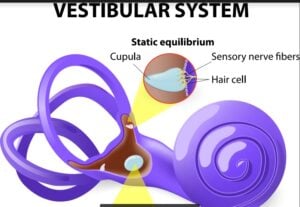
The vestibular system
The vestibular system is located in each inner ear. The system contains semicircular canals that contain a fluid with tiny hairs that can detect movement, on the inside of the canals. These hairs send information to the brain to help assist with balance.
This information helps the brain work out whether you are moving backwards or forwards, up or down, and whether you are lying down or standing up.
While the inner ear balance system is a great back up system it cannot be solely relied upon, particularly when flying. When flying, the aircraft experiences acceleration and deceleration forces that can cause the inner ear fluid to misinterpret the information and send the wrong information to the brain.
Each ear contains three semicircular canals and these are roughly positioned at right angles to each other. They are aligned this way so they can detect movement in three dimensional space.
Some of the early warning signs for motion sickness include sweating and the individual may become quiet and pale.
Symptoms of motion sickness include:
- Pale skin
- Feeling nauseous
- Increase in sweat
- Loss of appetite
- Dizziness
- Inability to concentrate
- Shallow breathing
The dangers of motion sickness
For pilots, motion sickness is a real threat that must be avoided as much as possible.
Even slight motion sickness affects the individual’s cognitive function and ability to concentrate on any task. Severe motion sickness could actually lead to total pilot or passenger incapacitation.
Avoiding motion sickness
Eating a light meal before flying, and avoiding dairy food, is one way of reducing motion sickness. Also ensuring the cockpit is well ventilated and – for VFR pilots – that your eyes are on the horizon for the majority of the time, is helpful. Try not to make any abrupt head movements that could also disrupt the vestibular system.
Pilots are not allowed to take most motion sickness medication, but ginger tablets are a natural remedy which can be used in moderation and may prevent or reduce the effects of motion sickness. The good news is that over time, most student pilots build a tolerance for motion sickness and the symptoms eventually disappear.
Only take passengers flying on calm days
If you are taking a first time passenger for a flight, please don’t take them on a day with high winds, severe heat and or turbulence. It is a sure way to ensure the sick bag will be used and they will never want to fly with you again!

Fly the plane like an airliner (no abrupt flying)
If you are an instructor and do not want your student to get sick, or if you are a pilot and don’t want your passenger to get sick, this one is the easiest method I know to avoid air sickness. My recommendation to all pilots and flight instructors (other than when doing stall and steep turn lessons) is to fly the aircraft like a mini airliner jet. When you fly in an airliner there are usually no abrupt movements.
Climbs and turns are always made gently and slowly. This gives time for the vestibular system to catch up with what the eyes are seeing. Quick abrupt movements are a sure way to get everyone sick very quickly!
What to eat before flying
It is a misconception that having an empty stomach will help the body avoid air sickness. Having no food in your stomach is a sure way of getting motion sickness.
Being well hydrated and having something light to eat before flying is very important. Any oily or fried food and any dairy foods should be avoided. Foods such as bananas, breads, almonds and crackers are examples of foods that can assist in decreasing the chances of getting air sickness.
Treatment of motion sickness
It is also a good idea to take sickbags in the aircraft in case any passengers experience air sickness. If you or your passenger experience motion sickness, try to relax and get as much fresh air as possible. If you are flying with an instructor, inform your instructor.
Do not conduct any abrupt manoeuvres and keep your eyes on the horizon until the air sickness passes. Once you are on the ground, the quickest way to recover from the effects of motion sickness is to ensure you are well hydrated and to lie down in a cool dark room.
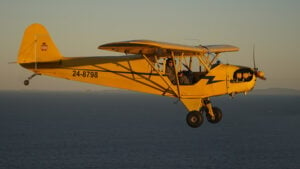
The good news is, you will get used to it (eventually)
The majority of pilots (myself included) eventually adjust to the effects of flying. Passengers may not, as they may not fly enough in light aircraft to overcome the effects of motion sickness, this is why flying on a calm day with no abrupt movements is so important when flying with passengers.
The more your senses are exposed to flying in three dimensions, the more the effects of motion sickness will reduce. I have known airline pilots and air force fighter pilots who suffered severe air sickness during their early training and eventually their bodies adjusted and they no longer experience air sickness.
Flying can be fun and rewarding. The more knowledge the instructor or pilot has about motion sickness avoidance, the more likely students will continue their flight training and become a student pilot themselves.
The GoFly Online Team wants to help you become the best pilot you can be, please try our free 7-day trial to access all of our flight training videos, theory books and practice exams. Happy and safe flying.
-
Why all pilots need to understand the ‘region of reverse command’
Unfortunately loss of control accidents are very common during take off and landing.
Many of these accidents could have been prevented if the pilot had a better understanding of slow speed flight and what is commonly known as the ‘region of reverse command’.
Region of normal command
Before we talk about the region of reverse command, let’s look at the ‘region of normal command’.
The region of normal command is where most aircraft spend most of their time, that is, in standard climb, level flight and descent.
In this region, an increase in airspeed causes an increase in parasite drag (drag caused by the structure of the airframe interacting with the relative airflow) and a decrease in induced drag (drag caused by lift).
To put this another way, in the region of normal command, when you pitch the nose up the aircraft’s airspeed decreases and the aircraft climbs; and when you pitch the nose down, the aircraft’s airspeed increases and the aircraft descends.
Region of reverse command
The region of reverse command is encountered at low airspeed. It is also known as the back of the power curve, and is normally situated below the max endurance power and airspeed combination for the aircraft type. This region is always encountered during take off and landing.
The aircraft is not behaving like it should!
In the region of reverse command, any decrease in airspeed will see an increase in total drag, and any increase in airspeed will see a decrease in total drag.
The graph below highlights what is actually happening. As you can see, at a certain airspeed, the total drag starts to increase again as the airspeed decreases.
This is the reverse of what happens at higher airspeeds, hence the term ‘region of reverse command’.
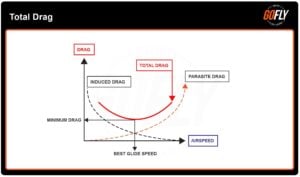
Low and slow on final
Imagine a pilot allows the aircraft to get low and slow on final approach and the airspeed enters the region of reverse command.
If the pilot decides to pull back on the controls to gain height, the total drag will increase and so will the rate of descent.
The pilot will be expecting the aircraft to climb but it may actually descend.
If the pilot was using a substantial amount of power (such as a short field approach) there may not have enough power available to arrest the sink rate and not enough height below the aircraft to pitch the nose down to increase the airspeed.
Things can get ugly quickly on takeoff!
Let’s assume a pilot is conducting a short field takeoff with full power and, due to a wet runway, the take off distance increases.
Just after takeoff the pilot notices trees at the end of the runway and is worried that they may not be able to climb over the trees even though they are climbing at the best angle!
To try to avoid the trees, the pilot pitches the nose up slightly to try and increase the climb angle to get over the trees. Unfortunately, by doing this, the airspeed decreases below the best angle of climb and into the area of reverse command.
At this airspeed, any decrease in airspeed will see the rate of climb decrease (as total drag is increasing) and potentially the aircraft will actually start to descend (or worse, stall).
As the aircraft is delivering full power there is no longer any available power to improve the rate of climb or airspeed.
The only way to improve your climb rate is to actually lower the nose to increase the airspeed before attempting to climb again (which is a hard thing to do if you can see trees heading towards the windshield!)
The relationship of power overcoming drag also reverses
If you look at the graph below you can notice that above the best ‘lift to drag ratio’, more power is required to increase the airspeed (to overcome drag), until it reaches a point where there is no more power available (maximum level flight speed).
However, below the best ‘lift to drag ratio’ line, more power is required to maintain level flight, as the airspeed decreases until it reaches a point at a very low airspeed (normally near, or at, the stall) where there is no more power available to maintain level flight.

Here are some simple rules on how to avoid unrecoverable situations in the region of reverse command.
Know your aircraft’s limitations
It is important to know your aircraft’s correct airspeed and limitations by reading the POH (Pilot Operating Handbook).
For instance, if the short field take off and landing airspeed is 65kts, then under no circumstance should you ever allow the aircraft to get below this speed! This also means understanding the performance and weight and balance charts for your aircraft type so you never have to put yourself and your passengers in a marginal situation with no buffer.
Ensure a stabilised approach
A stabilised approach includes a stable approach speed, stable rate of descent and the correct approach profile. If any of these variables are not met, particularly below 200 feet, conduct a missed approach.
Do not fly below best angle airspeed (VX) on take off
For takeoff, ensure the aircraft does not adopt the climb attitude until the airspeed can maintain the minimum safe climb altitude and airspeed.
Slow speed flight and approaching the stall
The best technique is always to avoid a stall. Proper initial training plus refresher training with a qualified instructor on slow speed flight and stall avoidance is very important.
Know your own limitations
If you have not done a short field takeoff or landing for a long time and you’re not feeling confident doing one, then don’t! Find an appropriate flight instructor and do some refresher training to ensure you are confident before conducting these types of takeoffs and landings on your own.
If you balloon or bounce on landing conduct a missed approach
For most light aircraft and in particular light sport aircraft, if the aircraft balloons or bounces on landing, the best decision is to conduct a missed approach. The aircraft is usually already in the region of reverse command on landing and any attempt to try and recover at this low airspeed with insufficient height below you, is very dangerous.
Applying full power and allowing the aircraft to accelerate to a safe climb speed is always the best option.
Slow flight does not have to be dangerous
If slow flight is conducted within the designated limitations of the Pilot Operating Handbook by a qualified and current pilot, it does not have to be dangerous.
Understanding the how, what and why of the ‘region of reverse command’ is the first step in avoiding a negative outcome!
Happy and safe flying and see you next time on GoFly Online.
The GoFly Online team wants to help you become the best pilot you can be. You can access all of our flight training videos, practice exams and theory books with the 7-day free trial.
-
What documents do pilots need to carry on board the aircraft when flying?
What documents do pilots need to carry on board the aircraft when flying?
It is important for all pilots in Australia to know what documents they must legally have on board the aircraft when flying. It can be quite confusing understanding the legal requirements and where to find the most up to date legislation in relation to documentation requirements.
As the pilot in command, knowing these requirements will not only ensure you meet your legal obligations but also give you peace of mind should you get a ramp check or spot audit from CASA or Recreational Aviation Australia (RAAUS).
Here is a list of items that need to ALWAYS be carried on an aircraft when flying in Australia for day VFR flights. These references can be located on CASR 91.105, 91.110 and the Recreational Aviation Australia Operations Manual and VFRG.
Flight Crew licence
A Pilots Licence holder must have a valid Flight Crew licence on them at all times.
If they have a Recreational Pilot Certificate with RAAUS, while it is a good idea to have the Certificate on you, it is not a legal requirement. As per the RAAUS Ops Section 2.03, Recreational Pilot Certificate holders only have to produce the documentation within 72 hours of being requested by RAAUS or CASA.
Medical Certificate
For a CASA pilot licence holder, it is a requirement to have your Medical Certificate on you at all times.
For a Recreational Pilot Certificate, if you are required to have a medical certificate, then once again, as per the RAAUS Operations Manual, the pilot has 72 hours to produce the document if requested by RAAUS or CASA.
Photographic ID
All pilot licence and certificate holders are required to have photographic ID on them at all times. This can be a passport, an ASIC card or a driver’s licence.
Flight Manual or Pilot Operating Handbook (POH)
The aircraft Flight Manual or Pilot Operating Handbook must be on board the aircraft at all times.
Minimum equipment list for the aircraft type
If your aircraft type has a minimum equipment list, this equipment must all be onboard the aircraft. This list is often contained in the flight manual or Pilot Operating Handbook or could be a requirement for a particular commercial air operation.
Not required if doing aerobatics
There is an exemption from having to carry these documents if you are performing aerobatics and the documents could interfere with the safe operation of the aircraft.
Recreational and light sport aircraft
As per CAO 95.32 and 95.55 and the RAAUS Operations Manual, each aircraft must have a means of ascertaining current registration and valid airworthiness. This would normally mean a registration certificate on board and a type certificate, or for LSA aircraft, a special Certificate of Airworthiness on board the aircraft.
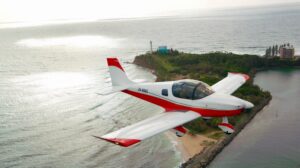
Other exemptions
As per CASR 91.110, the documents below are exempt from being carryied on board an aircraft, providing the flight is conducted within 50NM of the departure aerodrome flying within or traveling to and from a training area. These documents include
- Technical Log or Maintenance Release
- Authorized aeronautical information for the flight
If we look at this another way, if you are planning to depart from the departure aerodrome for more than 50NM or outside a training area then the aircraft must carry its Maintenance Release sheet. The aircraft must also have the relevant aeronautical information such as maps and other documents required to safely conduct the flight.
Do pilots need to have their Logbook with them?
As per CASR 61.345 and RAAUs Ops Manual 2.03, a pilot logbook is not required to be carried on board an aircraft. However, for Pilot Licence holders, the logbook must be presented to CASA within 7 days if requested by CASA. For RAAUS Pilot Certificate holders, the logbook must be presented within 72 hours if requested from Recreational Aviation Australia.
Documentation checklist
It is a good idea to have your own documentation checklist which is particular for your licence or certificate type, that you check every time you go flying. The checklist will also vary depending on whether you are flying within 50nm or the training area.
***
The GoFly Online Team wants to help you become the best pilot you can be. Feel free to take a look at our flight training videos, practice exams and theory books by signing up for the FREE 7-day trial at www.GoFly.Online
-
Will electric VTOL aircraft replace personal fixed-wing flying?
I have owned a Flight School for over 10 years now. The majority of our students are learning to fly for fun. The majority of recreational flight students have no ambition to turn their passion for flying into a career; they just want to learn for the sheer joy of flying.
The next aviation revolution
Currently there is a ‘quiet’ revolution going on with electric VTOL (vertical take-off and landing) technology. There are roughly 80 new start-up companies world-wide, designing, flight testing and trying to certify passenger carrying electric VTOL aircraft.
Some of these companies have had close to a billion dollars of private equity investment. Some of the most promising electric VTOL start-ups include Joby Aviation, Lilium, Kittyhawk, Archer and Beta, and then there are the big aerospace companies such as Airbus, Boeing and Embraer, all working on their own designs.
These companies are focusing on urban transport and are designing and certifying these new types of aircraft for affordable mass passenger travel. These aircraft only have a limited range (usually around 200km), however this satisfies densely urban transport such as city to airport transfers. Compared to current helicopters, the cost is projected to be up to five to ten times more affordable than current helicopter technology with less than half of the noise. This future VTOL market is estimated to be worth around a trillion dollars globally by mid-2035.
The effects on learning to fly
What has not really been discussed, is how this new technology will impact personal flying and in particular, personal fixed-wing flying. While most new startups are focused on the mass transport of passengers, some companies such as Jetson One and Air One are focused on the recreational pilot market.
Startup company, Air, an Israeli-based start-up, is solely focusing on the personal recreational market with their Air One electric VTOL aircraft. While the full-scale prototype is set to fly later this year, the initial performance projections are impressive, with a one-hour range at around 90 knots with 30 minutes reserve, and it can carry two people. The aircraft has eight electric motors and a ballistic recovery system (BRS chute) for additional safety. The Air One also will have AI (artificial intelligence) self-diagnostic software that will complete the majority of the pre-flight inspections on most of the systems on behalf of the pilot. Projected sale costs are similar to an upper-end of the market Light Sport Aircraft (LSA).
Will students still want to fly fixed wing, VTOL or both?
Will future recreational pilots wish to continue flying fixed-wing aircraft or will they see electric VTOL as a better alternative? There are a few things to consider when trying to guess the answer.
Most recreational pilots fly locally
While most of our students continue on to complete their navigation and passenger endorsements, the majority of pilots who fly for fun are content to fly locally (within 50 nautical miles of the departing aerodrome). Most recreational pilots just want to get up in their local airspace and enjoy the freedom of flying and maybe share it with a friend or family member.
Those students who want to fly longer distances, have usually learned for business-related reasons and end up purchasing their own aircraft to save regularly having to drive long distances.
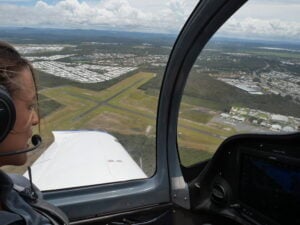
Learning to land is the hardest part of flying
Most people can be taught the basics of flying a plane, in a small amount of time. Landing however, is what separates the serious students from those who just think it will be cool to have a pilot’s licence.
It appears that piloting these new VTOL aircraft will be substantially easier than flying a fixed-wing aircraft. For instance, the take-off and landing in most of these VTOL aircraft will be computer-assisted. The pilot will not be responsible for basic stability in the hover, as is a helicopter pilot.
While mastering landings in a fixed-wing aircraft is rewarding, and some students love the challenge, I’m sure there are plenty of would-be students who would prefer this was a lot easier.
Runways optional
The other huge benefit for VTOL is that no runway is required. Theoretically they can take off and land almost anywhere.
While there are start-up companies working on this issue such as Skyportz, it will be a while before there are mass urban take-off and landing sites available for all VTOL types of flying, not to mention charging stations. The other factor is whether these sites will be available for personal use or only for commercial applications.
Range
Initially, range will be the biggest issue for early VTOL aircraft, the same as for early electric fixed-wing aircraft. I believe that within 10 years there will be hybrid VTOL (vertical take-off with a fixed-wing component, such as the start-up Beta, that can actually take off and land as a fixed-wing aircraft and have a range close to 400km.
Battery technology is also improving at a rate of about 5 to 7% per year. This means that within 10 years, energy density should double. This is not taking into account any major breakthroughs in battery technology (such as solid-state batteries).
Picture courtesy of Beta Technologies
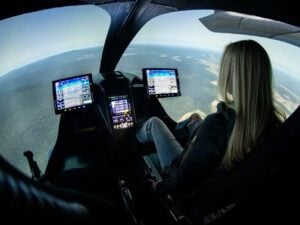 The future is exciting
The future is exciting While it is hard to predict the future, I think the personal VTOL aircraft revolution is still four to eight years away and when it arrives it is going to radically change urban transport and bring helicopter-like charter operations to the masses (rather than just the rich!).
There will still be plenty of individuals who will want to learn to fly in a fixed-wing aircraft. There is something magical about mastering a landing in a fixed-wing aircraft and as all pilots know, you never stop perfecting your landings. However, I think flying a recreational VTOL will also be rewarding in new ways. It is possible that this new technology will open up new opportunities and entice more tech-savvy pilots into the recreational flying space.
I can envision a future where a flight school has both electric fixed-wing aircraft and electric VTOL aircraft. Some pilots will be attracted to one type and some pilots will want to do both. The issue over the next five to eight years will be deciding who will manage the training and regulatory/safety aspect of these recreational VTOL type aircraft.
While Commercial VTOL will be governed by CASA in Australia, who will take the regulatory lead with recreational VTOL aircraft? For instance in Australia, will it be governed directly by CASA, or by Recreational Aviation Australia, or some new self-administering organisation?
I don’t have the answers, but I think we need to start having the conversation now so we can all have a part in creating our flying (for fun) future. While it’s impossible to predict exactly what the future will hold, there is no doubt that the future of personal flying will be very exciting.
Damien Wills, CEO GoFly Group
Feature photo courtesy of Air One
7 Day
FREE
Trial
Get access to the complete catalogue of your chosen subscription level for 7 days. After your free trial, your paid subscription automatically commences. Cancel anytime.
Get FREE TrialOur
Partners


